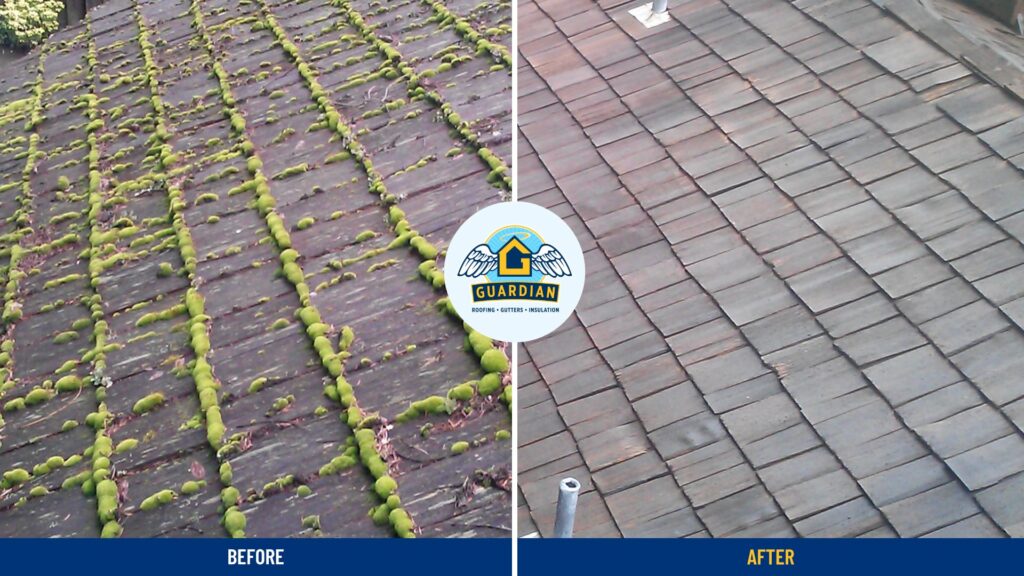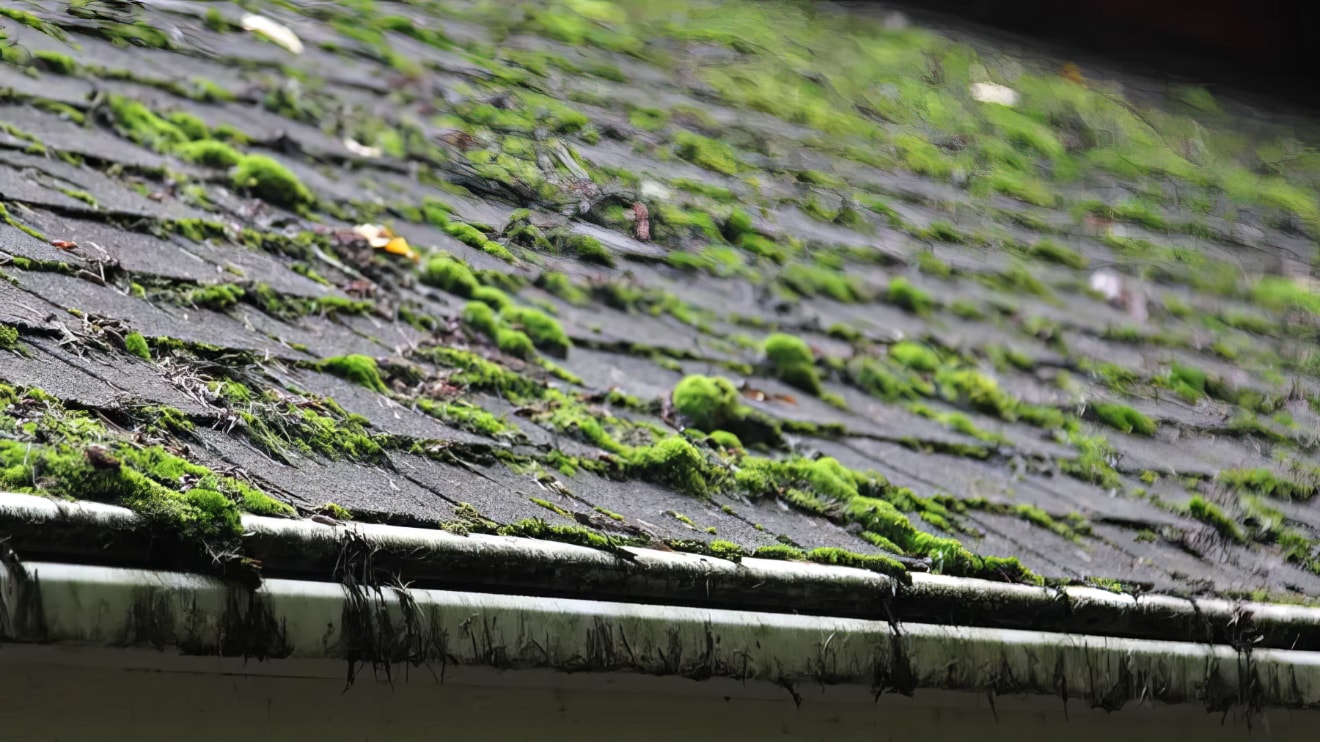Spring Roof Inspections are Key to Surviving Moisture Damage and Decay
February 18, 2025 (SEATTLE) – Guardian Roofing, Gutters & Insulation, the trusted name in roofing and home services throughout the Pacific Northwest recognizes that the region has a unique climate that makes moss and algae growth a common problem on home roofs. With high moisture and frequent rainfall, attention to roof maintenance can prevent the creation of a damp environment that causes moss and algae to thrive.

“Roofs retain moisture, particularly in shaded areas, allowing moss to take root,” says Matt Swanson from Guardian Roofing. “Unlike hotter regions where sunlight can dry and kill moss, the PNW’s temperatures keep surfaces damp longer. Tall evergreen trees and overcast skies mean many roofs get limited direct sunlight, preventing roofs from drying out. In addition, north-facing and heavily shaded areas are especially prone to moss and algae growth.”
When inspecting roof conditions, Guardian pays attention to the design factors, like low-pitch roofs that tend to hold more moisture, accelerating moss growth. Poor drainage and clogged gutters will also exacerbate moisture retention.
“The structural and aesthetic damage of moss and algae growth can contribute to roof deterioration, shortening the lifespan of your roof. The longer moss is allowed to grow, the more irreversible damage is done to your roof,” continues Matt Swanson. “Moss roots can lift shingles, leading to leaks and water damage, while algae can create dark streaks, reducing curb appeal and potentially affecting home value. DIY removal can be dangerous due to slippery conditions and roof height, so we always recommend a spring roof inspection to get ahead of potential problems.”
With an inspection and assessment, Guardian Roofing, Gutters & Insulation technicians will evaluate the extent of moss and algae growth. They will check for roof damage, including lifted shingles, leaks, degranulation, and clogged gutters. Then, a customized treatment plan is created based on the roof’s material and condition.
“The best way to prevent moss is with regular maintenance, keeping roofs free of dirt and debris. We recommend a full roof inspection and moss treatment at least once a year. However, if your home is in a heavily wooded or shaded area, a cleaning every 6 months may be necessary,” says Matt. “The experts at Guardian are available to help combat moss and algae’s unnecessary wear and tear on homes in the Pacific Northwest, giving peace of mind to homeowners all year long.”
About Guardian Roofing, LLC
Founded in 2005, Guardian Roofing, LLC is an award-winning professional roofing contractor in the Portland and Seattle markets including the Washington state counties of King, Pierce, Snohomish, Kitsap, Clark, and Thurston; and now Oregon counties of Marion, Washington, Multnomah, Clackamas and Yamhill, serving the entire Pacific Northwest.
Founders Lori and Matt Swanson have more than 60 years of combined roofing experience and employ a team of more than 100 skilled and professionally certified craftsmen who assist customers with their roof, gutter, attic, masonry, and skylight needs. In 2024, Guardian Roofing, Gutters & Insulation, an A+-rated company by the Better Business Bureau, was named as a top 100 Roofing Contractor in the U.S. by Roofing Contractors Magazine. The family-owned company was also recognized in 2022 as one of the fastest-growing private companies by the Puget Sound Business Journal. Licenses: Roofing: LIC #GUARDR*847RO
###
Media Contact:
Dana Cobb
The Barber Shop Marketing
972-955-9747
dana@thebarbershopmarketing.com
Frequently Asked Questions
Moss does not only grow on the north side of trees, and homes. Moss will grow anywhere that there is an adequate of moisture, and sunlight. (Or lack thereof)
Moss likes to grow in shady moist conditions where the temperature is over freezing, and under 70 degrees Fahrenheit. When it gets warmer moss becomes dormant, but may not die.
Moss does not have roots so it needs running water to survive. (Like on roofs) Since it does not have roots it can grow on anything. Asphalt, wood, we even see it grow on glass, and metal roofs. In the Pacific Northwest tree debris, and even pollen that collect on the roof can create a dam that moss can grow on.
So if you aren’t supposed to pressure wash what should you do?
Common roof cleaning methods include:
- Pressure Washing: Suitable for certain types of roofs, but can damage shingles if not done correctly.
- Soft Washing: Uses a lower pressure and a high volume of water with a mixture of cleaning solutions to remove growths without damaging the roof.
- Chemical Cleaning: Involves applying chemicals designed to kill moss, algae, and lichen without the need for high-pressure washing.
- Moss Cleanup/Proofing: To clean a roof with moss, it’s often recommended to apply a moss-killing product and then gently remove the dead moss by brushing or low-pressure washing, followed by preventive treatments to inhibit future growth.
The key to dealing with moss is being proactive. In the Pacific Northwest we are truly blessed by our clean environment (Crucial for moss growth) and beautiful large evergreen trees. And some people say it rains around here once in a while.
Unfortunately the combination of these things make for perfect fungus and moss growth conditions.
So what can you do? Depending on your circumstance, and environmental consciousness here are a few suggestions.
- Remove any foliage or structures that might be shading an area to the point that sun rarely or never hits it.
- Keep the roof free from decaying organic material. I.E. Leaves, Needles, Pine Cones etc. Depending on the volume, if you are like most Northwestern Homeowners a minimum of a fall cleaning and a spring cleaning is necessary.
- Keep the Fungus off of the roof. Fungus and algae grow on everything in the Northwest as well. It is easily treated, and needs to be stayed on top of.
Moss on a roof is usually quite visible, appearing as green, fuzzy patches that thrive in damp, shaded areas. Moss holds moisture against the roof surface like a sponge and roots in the granules, which can damage the roofing materials over time.

